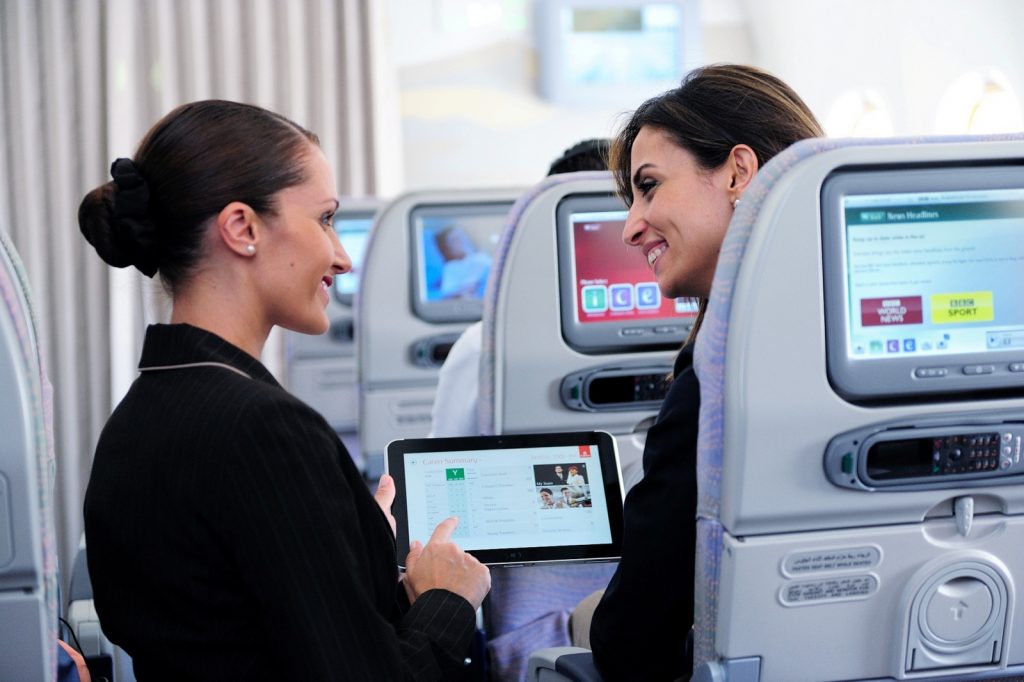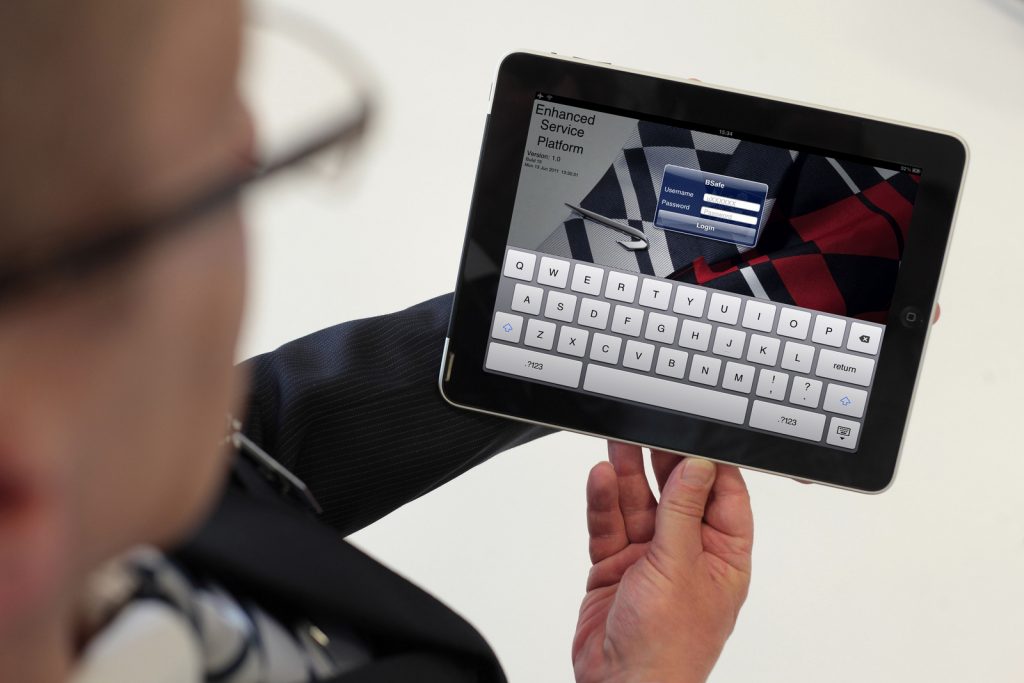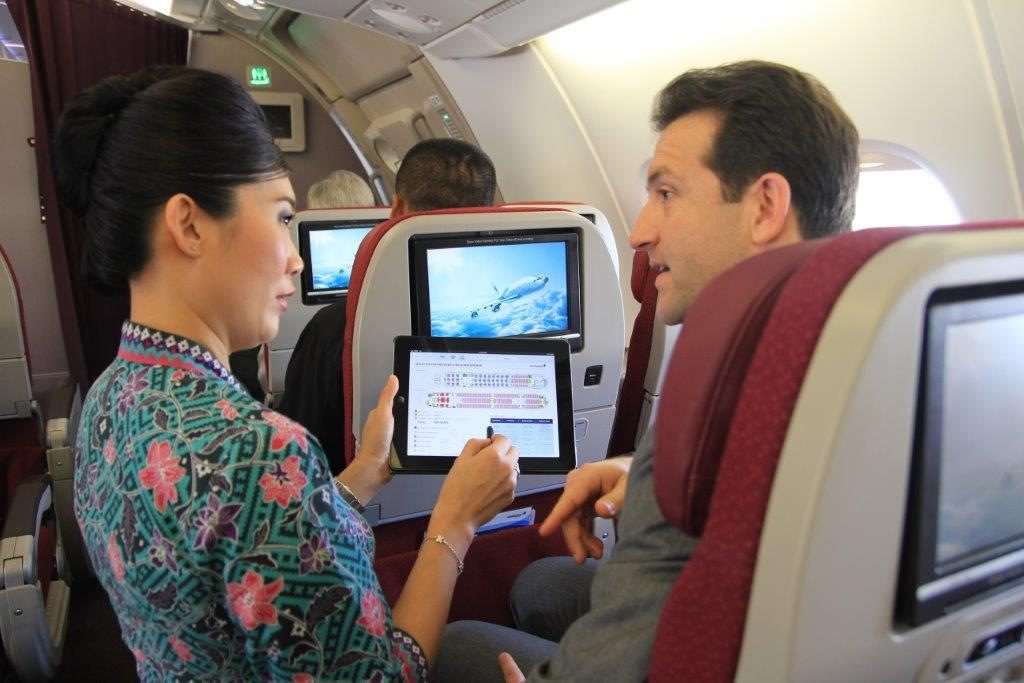
Emirates uses HP tablets with its Knowledge-driven In-flight Service (KIS) System app. Photo: Emirates
Written for the Airline Passenger Experience Association
APEX Experience Magazine – Issue 5.2 – March/April 2015
It looks like Star Trek got it right, again.
Long before we had tablet computers, the crew of the Enterprise “D” could be seen running to Captain Picard with devices that looked suspiciously like an iPad or Galaxy Tab. The captain would examine the starship’s latest status report, a plan to deal with the Borg, or maybe just the lunch menu at Ten Forward. He’d touch a few buttons on the screen, hand the device back, and say, “Make it so.”
Now, in our timeline, on mere jet-powered aircraft, cabin crews are using this Star Trek-esque technology as a new way to connect with their passengers. Faster than you can say “Engage!” airlines are equipping their crews with tablets, smartphones and in-between “phablets.” In-flight, there’s already a myriad of devices and software that mirrors the diversity in the consumer marketplace.
EARLY ADOPTERS
The first generation of Apple’s iPad was introduced in 2010, and Japan’s All Nippon Airways (ANA) was an early adopter of in-cabin tablet technology. ANA rolled out 6,000 iPads beginning in late 2011, initially as a cabin-crew training device that held ANA’s operational manuals. Since then, ANA has added videos that showcase duty-free merchandise to passengers, along with crew-use-only video that demonstrates in-flight meal presentation. ANA cabin crew also use their iPads to write administrative reports, which are downloaded as soon as the flight arrives.
THE NEXT GENERATION
At American Airlines (AA), the technology evaluation team decided that a tablet-sized device was too big, and a smartphone was too small for cabin crew in-flight use. So AA’s “Goldilocks,” in-between pick was the Samsung Galaxy Note series “phablet” – just right! Charles Sucur, AA’s senior manager, Flight Service and Onboard Products Technology, says, “Our flight attendants felt that it was easy to handle and store, while providing great readability. The Galaxy Note also fits nicely in the palm of the hand.” The Note has an e-version of AA’s in-flight crew manual, reflecting the airline’s goal to be paperless. Traditional paper-based passenger manifests and catering papers for in-flight food and beverage are the next targets to be “e-converted.
AA flight attendants must carry a Galaxy Note as “required equipment,” and each device is equipped with a custom-designed credit-card-reader case. The Galaxy Note is “used for in-flight sales, and enables enhanced customer service by providing [the crew with] real-time access to seat assignments, special services, premium-class food and beverage options, loyalty-program status, and connecting gate information,” says Sucur.
Other applications in AA’s Galaxy Note include mobile crew check-in, corporate e-mail, data-content management, an in-flight reference library, video clips, and what might be the most useful app, Google Translate. With the merger still in progress, legacy US Airways crews will be receiving their tablets through to March 2015, and AA will upgrade to the Galaxy Note 3 starting this year.
PURSER PADS
Emirates has equipped the purser on each of its flights with the HP ElitePad 900 tablet, running Windows 8 and the airline’s “Knowledge-driven In-flight Service (KIS) System” application. “Pursers and cabins crews are much more efficient in delivering the best in-flight experience, and the use of the tablet enhances on-board teamwork,” according to Kevin Griffiths, Emirates’ senior vice-president, Service Delivery Support. “Before each scheduled departure, pursers must familiarize themselves with the 16 to 24 crew members from different parts of the world. With KIS, pursers can look at their team ahead of time and learn about their skills, languages they speak, and experience,” he adds.
The KIS app gives pursers the ability to expedite in-flight upgrades based on passengers’ points, and a customer’s profile information and preferences are also updated on the tablet. Griffiths says, “Customer information is presented in easy snapshots, so pursers know if it’s someone’s birthday, or what a passenger prefers to eat or drink.” The tablet replaces traditional paper processes with apps for all post-flight reporting and cabin-crew performance reviews.
Griffiths says that Emirates chose the ElitePad tablet “because it’s a sleek device that is rugged enough to stand up to in-flight use. Being a global airline, we also liked that HP offers worldwide hardware delivery, service and support.”
CUSTOM SERVICE
British Airways’ (BA) senior cabin crew are equipped with iPad 2s that are refreshed just prior to departure with an up-to-the-minute passenger and preference list. According to the airline, “The iPads enable cabin crew to have prior awareness of customer preferences and a greater understanding of each customer’s previous travel arrangements, allowing them to offer a bespoke, personalized service.” And, really, what would BA be without “bespoke” service!
Similar to other airlines’ implementations, BA’s applications include seat maps, passengers’ Executive Club status and meal requests, and a library of timetables, safety manuals and customer service updates.
MINTED MINIS
Since fall 2014, in-flight lead crew members on JetBlue’s transcontinental Mint-equipped A321s have been using iPad minis, the first step in a system-wide deployment that will be complete by summer 2015. Shane Bennett, JetBlue’s manager, Customer Experience Solutions, says, “Since we started flying 15 years ago, we’ve always had a focus on innovation, like personal-screen satellite television. It’s not just innovation for innovation’s sake, though. The purpose of those innovations, as always, has been to provide our passengers with a great experience.”
JetBlue formed a working committee of in-flight crewmembers to assess the hardware and software options, and tested several devices on various operating platforms. “One of the biggest benefits of transitioning to a tablet is the ability to regularly update software as improvements are rolled out by developers,” says Bennett.
The iPad minis run JetBlue’s Inflight Service Assistant (IfSA), a purpose-built application and crew portal. IfSA is used for in-flight point-of-sale processing of products and services; gives the crew an interactive passenger manifest; has crew pairing, flight, hotel and transportation info, along with a mobile crew check-in app; includes a 20-language Google translation app; and it replaces JetBlue’s paper, 300-page flight attendant manual with an e-document. JetBlue still uses paper in the cabin, but according to Bennett, it’s just “for a handful of regulatory-required documents. However, we expect to eventually be completely paperless.”
WALKING ON AIR
SITA OnAir’s CrewTablet is now flying with Etihad, Aeroflot, Air Caraïbes, and Malaysia Airlines. Through a mix of application modules, CrewTablet “personalizes the passenger experience with passenger information,” says Ian Dawkins, OnAir’s CEO. Thanks to its standard and open architecture, CrewTablet can run on iOS, Android and Windows devices, and is designed to integrate with various back-end IT systems. “SITA OnAir is able to customize CrewTablet to adapt it to the unique IT environment of each airline,” adds Dawkins.
As well as providing crews with seat-map-based passenger information, on-board retail processing, crew training documents, airline reports and flight information, one of the CrewTablet modules can download last-minute baggage information. “If a bag does not make it onto a flight, the affected passenger can fill out lost-bag forms on the tablet, which gets passed on to baggage tracing upon arrival,” says Dawkins.
SITA OnAir estimates that, on average, CrewTablet digitizes around 15 paper reports per flight, as well as replacing upwards of 30 pounds (14 kilograms) of paper manuals. And, in step with the company’s development of the “connected aircraft,” it’s exploring how to connect CrewTablet to an airline’s operations center through “OnAir Plug,” SITA OnAir’s secure, dedicated wireless network providing in-flight Internet access for crew and aircraft operators. Dawkins says, “Connectivity opens up an array of new functions, such as live retail payments, and telemedicine for passengers taken ill.”
So, years back, Star Trek communicators became our cell phones. Now we have tablets. With the strides being made in 3-D printing, is a replicator galley far off? Or perhaps holographic in-flight entertainment systems will be next. How about a transporter? Wouldn’t that change the game!
Read the original story in the APEX Experience Magazine – APEX.aero.

